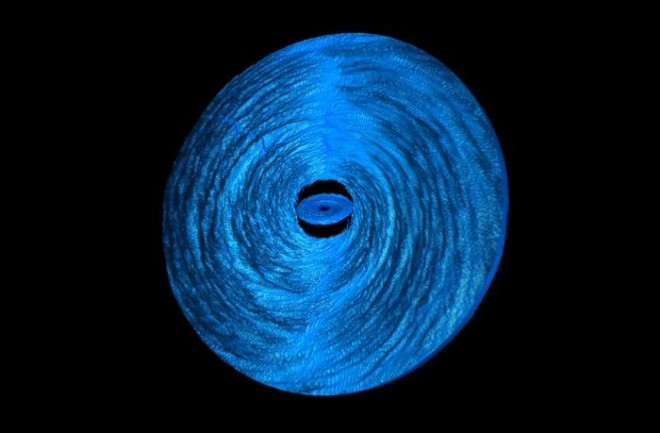A supercomputer at the Oak Ridge National Laboratory in Tennessee called Summit takes up the same floor space as a couple of tennis courts, and weighs more than a large commercial aircraft.
In certain cases, the machine can perform about a billion calculations per second, allowing it to simulate complex systems in physics, biology and other fields.
Recently, a team of astronomers used Summit to simulate a supermassive black hole and the swirl of matter (the “accretion disk”) that surrounds it, considering all of the attendant gas dynamics, magnetic forces and warping of space.
Their findings run counter to the traditional idea that a black hole dines on its accretion disk in a relatively leisurely manner. Instead, the team found that the simulated black hole scarfed down matter voraciously and effectively made a mess of its plate in the process.
Simulating a Black Hole
The results of the simulated black hole could help to explain a type of quasar that flares up unexpectedly and vanishes just as quickly. Quasars contain supermassive black holes that emit staggering amounts of light as they ingest large clouds of gas.
“Classical accretion disk theory cannot explain this drastic variation,” said Nick Kaaz, a graduate student at Northwestern University, in a statement. “But the phenomena we see in our simulations potentially could explain this.”
Under the classical theory, an accreditation disk rotates in sync with a black hole and gradually falls below its event horizon, the point beyond which no light can escape. This takes a long time, between hundreds or even hundreds of thousands of years.
The model black hole, however, ate at a lightning pace and cleared the inner, light-producing section of its plate in a matter of months, about how long it takes the shortest quasars to cycle.
Read More: This is What a Black Hole Sounds Like
Testing the Classical Accretion Disk Theory
The simulated black hole yanked and pulled the very fabric of space around it, which caused the accretion disk to wobble. As it warped, gas from different areas collided and emitted powerful bursts of light.
Eventually, the inner section of the disk broke free and started wobbling in a different pattern. This was evidence of the black hole winning out against the forces of friction, which would otherwise hold the disk together.
Read More: What Would Happen if You Fell Into a Black Hole?
Down the Rabbit Hole
The outer section collided with the inner one, and the added mass helped the inner to fall into the center of the black hole. Then the outer flowed into the empty inner section, and the cycle started over.
“The inner region of an accretion disk, where most of the brightness comes from, can totally disappear over months,” said Kaaz. “We basically see it go away entirely. The system stops being bright. Then it brightens again, and the process repeats.”
If scientists can better understand accretion disks and how they emit light, they can better characterize the quasars and other light-producing black holes seen through telescopes.
Read More: What Happens To Us If Earth Falls Into A Black Hole?

